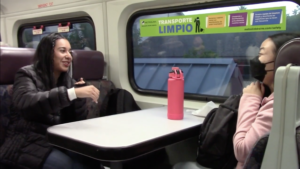California State University Northridge has a reputation as a commuter school — but for many students, that commute isn’t easy.
The Sundial newspaper reported that in the late 1980s, CSUN expanded student housing with the vision of providing more housing like traditional, four-year residential campuses like UCLA and USC.
Although the university did add more dorms and apartments onto campus, students still comprise a huge majority of the student body at CSUN. A recent report from CSUN’s Institute for Sustainability suggests only a fraction of the university’s students live on-campus.
On average, faculty and staff commute to campus four days a week, traveling 11 miles each way. More than 60% of students say they don’t use public transportation to come to CSUN, and most commute alone, the report found.
Only 12% of students use public transit as their primary mode of travel.
“The transit system is not reliable for traveling distances,” said Henrik Minassians, a professor of urban studies at CSUN.
Minassians noted that ridership on L.A. Metro buses and trains was declining before the COVID-19 pandemic hit, and hasn’t recovered since the pandemic began. This has triggered service cuts that could make it harder for CSUN students to rely on transit for a ride, Minassians said.
“Metro, in order to recover their costs, they are cutting back from the various lines,” the professor said, “and how long you have to wait to change your line or to get onto the next bus to get to campus.”

CSUN student Melanie Guerrero takes the Metrolink train to campus from Oxnard, an approximately 40-mile one-way trip. (Image by Lupita Baltazar/On Point)
Many students prefer to commute and save money on housing either on or near campus.
CSUN students pay as little as $7,260 per year and as much as $15,890 annually to live in on-campus housing.
But Melanie Guerrero saves on these costs by living in Oxnard with her family. She commutes by train, making the round trip to campus of more than 80 miles two or three times each week.
In exchange for enduring the commute, Guerrero can stay at her job at Oxnard and has the support of her family close by.
But commuting by train to campus does pose a few challenges.
“The hardest part is probably the beginning of every semester when I’m trying to plan out my class schedule,” Guerrero said, “just because I really have to plan my classes out to a train schedule. It is not my own time, it’s the train time.”
Guerrero once needed to take a class that did not correlate with the train schedule, which was a huge inconvenience. The class was a graduation requirement for Guerrero, a broadcast journalism major. Luckily, Guerrero and her advisor figured out a way to resolve the conflict.
Even if CSUN wanted to expand public transportation, the decision to provide these services ultimately will fall with local governments, like the city of Los Angeles, the county, and L.A. Metro.
These agencies sometimes face resistance to plans to expand transit. For example Balboa and Neighborhood Council canceled the ideas and plans for there to be more available public transportation for students and how the city puts more funds towards light railes rather than more connected buses.
“Majority of the public transit money goes more into light rail, instead of more connected designated lanes or buses,” said Minassians, “and as a result, we are seeing more and more [that it’s] very difficult for the public in general, especially CSUN students, to rely on public transit to system to get to campus in a timely fashion.”
This show was produced by Lupita Baltazar, Justin Borses and Sade Pullen

 Tweet this Video
Tweet this Video Share on Facebook
Share on Facebook Share via E-mail
Share via E-mail

